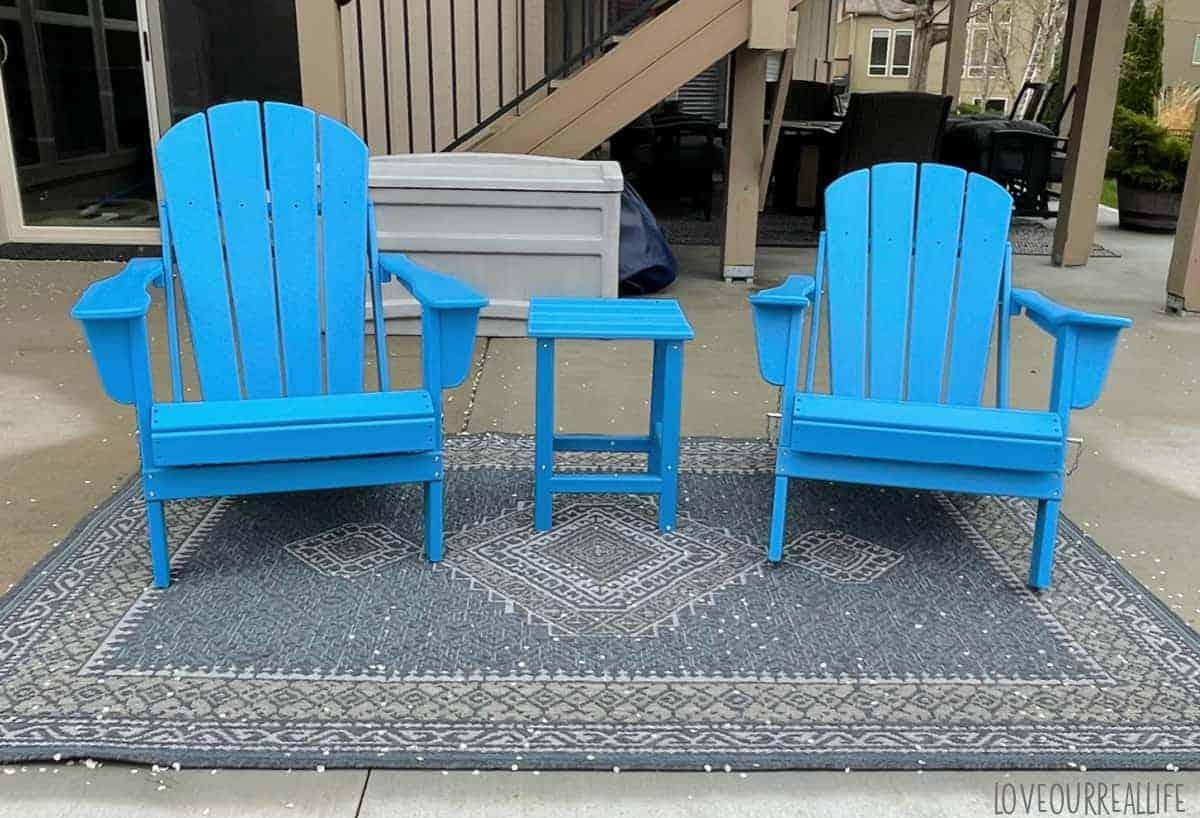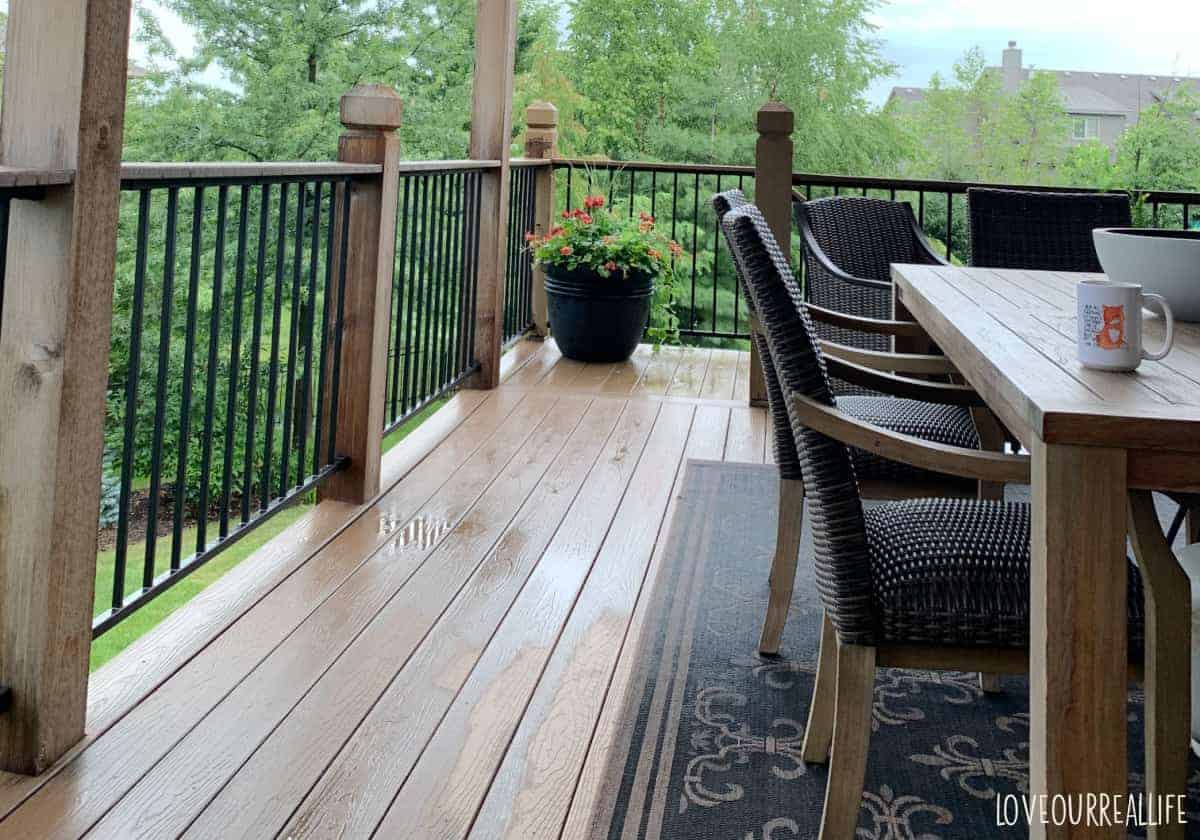Do you have outdoor rugs? Find out how to quickly dry them out when they get soaked from rain or snow.
Outdoor rugs can be left outside, even in wet, rainy weather if made with the right materials. Synthetic materials such as polypropylene are more durable and less prone to mildew than rugs made with natural fibers such as jute or sisal.
You are watching: What Happens When Outdoor Rugs Get Wet- Quick Tips & Advice

Get more outdoor project ideas and decor tips here.
Learn the best rug materials for your outdoor area. Then, follow these tips to ensure your outdoor rug will last several seasons and how to care for an outdoor area rug when it gets wet.
Jump to:
- Can outdoor rugs be left outside?
- What are the best materials for outdoor rugs?
- Can outdoor rugs get wet?
- Do outdoor rugs get moldy?
- How do you keep outdoor rugs from molding?
- How do you protect indoor outdoor rugs?
- How do I waterproof an outdoor rug?
- Can Outdoor Rugs go on Unsealed Concrete?
- How to Clean an Outdoor Rug
Can outdoor rugs be left outside?
Yes, your outdoor rug can be left outside. Of course there are a number of variables to this question, however. Not all outdoor carpets are created the same.
First things first.
Did you select a material that is UV-resistant? Will the rug be in direct sunlight where fading could be an issue?
Will your rug be placed in a covered area such as a covered porch?
If placing on concrete, is your concrete patio sealed?
Will your rug be on a deck? If yes, what types of materials can help you reduce the risk of causing the wood on your deck from deteriorating or rotting?
Is the rug going to be in high-traffic areas?
Let’s start answering some of these questions!
What are the best materials for outdoor rugs?
Here is a breakdown of outdoor rug material and rug fibers to help you select the right material for your outdoor space.
Synthetic Fibers
- Polyester
- Polypropylene
- Acrylic
- Nylon
Pros and Cons of Polypropylene
Pros
Polypropylene, or olefin, is an incredibly durable outdoor rug material. It is a man-made fiber that is thermoplastic.
Due to the nature of polypropylene it is easy to clean, resistant to moisture and color loss, is stain-resistant, is lightweight, and it’s inexpensive. It is generally considered to be non-toxic, safe for pets, and does not contain bisphenol A (BPA).
Read more : How to Get Rid of Crickets: Reduce the Chirp With These 5 Methods
Olefin rugs are good for all outdoor locations, including wood decks and concrete!
Cons
While a great outdoor fiber, polypropylene is not terribly environmentally friendly. Because of its makeup, it does not easily degrade.
In my opinion polypropylene is the best all-around fabric for outdoor rugs.

RELATED: How to Paint Outdoor Metal Furniture
Pros and Cons of Polyester, Acrylic, and Nylon
You will see polyester, acrylic, and nylon listed as the primary material for many indoor/outdoor rugs.
Pros of Nylon rugs: good durability and hold up very well in high traffic. areas. Cons of nylon: tend to be more expensive and it does retain heat.
Pros of Polyester rugs: minimal fading in the sunlight and often comes in nice, bright colors. Typically soft feel. Cons of polyester rugs: not very durable for high traffic areas and tend not to hold up as well in outdoor settings when regularly exposed to elements.
Pros to acrylic rugs: good resistance to mold and mildew. Cons of acrylic rugs: stains more easily than many other man-made fabrics and does not hold up well in heavy traffic use.
Also note, many rugs made with polyester, acrylic, or nylon might also contain natural fibers. Be sure to check the label! While this makes for a pretty rug, they will be more susceptible to mildew and mold.
Avoiding this will save you from extra work in your outdoor area.
Natural Fibers
Common natural fibers used for outdoor rugs include:
- Seagrass
- Sisal
- Jute
- Bamboo
- Hemp

Pros for natural fiber rugs: Beautiful, environmentally friendly, coordinate well with many decor themes.
Cons for natural fiber rugs: Tend to hold moisture and mildew more easily. They do tend to decline in quality over time because of this. Natural fiber rugs are not recommended for wood decks.
Can outdoor rugs get wet?
Yes, outdoor rugs can get wet. As outlined, rugs man-made rugs made of synthetic fibers, especially polypropylene, are the most durable and least likely to foster mold and mildew. Natural fiber rugs such as jute and sisal can get wet, however you must take care to ensure the rugs dry properly.

If you desire to use a natural fiber rug in an outdoor setting, it would work best in a sheltered area such as a covered porch or deck that does not get overly exposed to the elements.
Read all about our deck and outdoor space makeover!
Do outdoor rugs get moldy?
Unfortunately, natural fiber outdoor rugs have a tendency to become moldy if not properly cared for.
Read more : How to Choose the Best Wood for Patio Furniture
Most synthetic rugs are mold and mildew-resistant, making them a much safer choice for an outdoor rug.
However note that even with synthetic rugs, you can eventually notice mildew and mold growth if they remain wet for long periods of time.
How do you keep outdoor rugs from molding?
You can keep an outdoor rug from molding by avoiding moisture. This includes rain, snow, heavy dew, precipitation of any kind, and humidity.
But we all know that avoiding moisture is next to impossible if you have an outdoor rug!
So the BEST way to keep an outdoor rug from molding is by selecting a rug made from synthetic fibers. The most mildew-resistant outdoor rug fiber is the water-resistant polypropylene.
How do you protect indoor outdoor rugs?
If you select a durable rug that is also stain, mold, and mildew-resistant, you have done the hard work against protecting your indoor-outdoor rug from the elements. As mentioned, synthetic fiber rugs will hold up well in outdoor elements and require less effort on your part.
However, if you still opt for a natural fiber outdoor rug, there are steps you can take to increase the life of the rug if exposed to excess moisture.
How to care for natural fiber indoor-outdoor rug
- Place rug in a covered area, away from direct contact to the elements
- Avoid direct sunlight
- If rug does become wet, hang to thoroughly dry
- Regularly vacuum dirt and debris
- If spills happen, care for it immediately
- Use a rug pad that is appropriate for the surface where the rug resides
Note, it is my recommendation to save the natural fiber rugs (i.e., jute, sisal, seagrass, bamboo) for use as indoor rugs or perhaps an outdoor room that is sheltered from contact to precipitation.
How do I waterproof an outdoor rug?
While selecting a rug that is inherently waterproof is most ideal (i.e., polypropylene), sometimes you will need to simply waterproof a rug you already have.
Scotchgard Outdoor Watershield could possibly provide some level of waterproofing for an outdoor rug. NOTE: this is NOT made for outdoor rugs and carpets, but for outdoor fabrics.
I have not tried this on rugs that are not waterproof, but it might be worth investigating.
Can Outdoor Rugs go on Unsealed Concrete?
Your best bet is to place outdoor rugs on sealed concrete.
However, if placing an outdoor rug on unsealed concrete, your rug should be made of breathable materials to help avoid issues with mold and mildew.
I have used synthetic outdoor rugs on our unsealed concrete patios for years with no real concerns. But, you should note that rugs do have a tendency to trap in moisture on some level with nearly all rugs.
But on a positive note, outdoor rugs can be great to hide cracks in concrete, absorb noise from a pool pump, provide a feeling of warmth on a patio, and make a patio feel more like a living space.

Read how I painted my outdoor patio cushions!
How to Clean an Outdoor Rug
No matter which type of rug material you purchase, at some point you will need to give it a good cleaning to keep it looking its best. Especially if you have kids or pets!
Be mindful of the material of your rug prior to cleaning.
How to clean an outdoor rug made with synthetic materials
- Shake out rug well, then vacuum any remaining dirt or debris
- Use a solution of dish soap, mild detergent, and warm water
- Gently scrub any areas with stains or mildew with a soft bristle brush
- Hose off the rug (if rug is made of synthetic materials) and let it sit in the sunlight to dry
Clean an Outdoor Rug made with Natural fibers
- Shake out rug, then vacuum any remaining dirt or debris.
- Spot clean any stains with a solution of dish soap, mild detergent, and warm water. Use a soft bristle brush to gently scrub any mildew spots or stains.
- Dab rug with warm water and hang to dry. Allow to dry thoroughly before use.

Source: https://gardencourte.com
Categories: Outdoor

